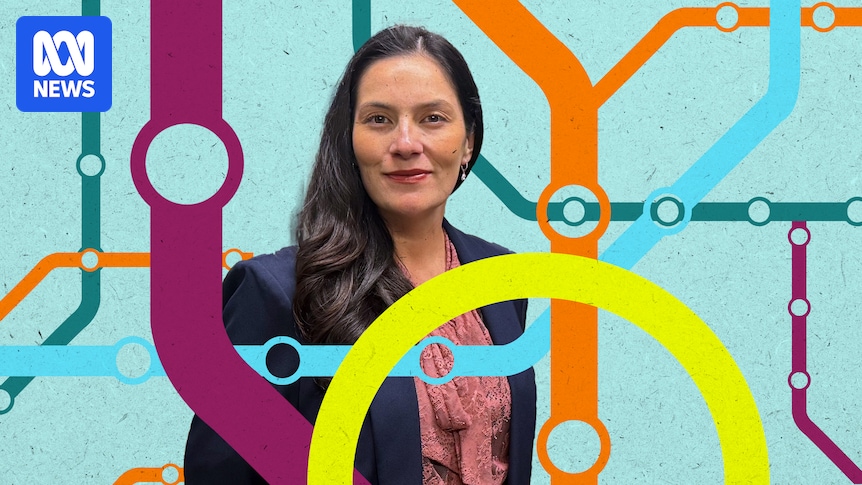Yazmin Cueva’s alarm sounds at 5am.
She needs those three and a half hours to make the journey from her home to work.
She could linger in bed a bit longer when she worked in Sydney’s central business district, catching one train from her St Helen’s Park home — a one-hour commute.
Now, it is multiple trains and a mad rush to her office in Parramatta.
“It’s stressful … I’m a mother as well, so I have to do all the things beforehand for the kids,” Ms Cueva told the ABC.
“I’ve had to learn to just get to the station early and be able to get whatever train is earliest.”
She said she arrived early because the trains might not “always be running on time”.
Yazmin Cueva said waking up about three hours before work starts to get into the office on time can be stressful. (ABC News Graphics: Lindsay Dunbar)
Ms Cueva’s commute generally takes about an hour and a half one-way.
This significantly exceeds the average, according to the latest Household, Income and Labour Dynamics in Australia Survey by the University of Melbourne and the Melbourne Institute.
It found that most Australians’ time travelling to work was decreasing since the coronavirus pandemic, with the average daily commute taking under an hour, or slightly less than 30 minutes one-way.
The study analysed the factors contributing to commute times, highlighting flexible work.
“The increase in working from home arrangements is one thing that has helped get commuting times significantly down,” Dr Inga Lass said, a senior research fellow on the HILDA Survey.
Bigger cities, longer commutes
The biggest cities often have longer work commutes, according to professor of transport David Levinson from the University of Sydney.
The cities with the longest commutes in Australia were three of its most populous cities: Sydney (59 minutes), Brisbane (56 minutes) and Melbourne (55 minutes).
The shortest commute in Europe was in Iceland, one of the smallest countries on the continent, where workers on average got to the office within 15 minutes.
While in Canada, the place with the longest commute was Toronto, which also has the largest population of any city in the country.
There were a few reasons larger cities often led to longer commutes, Professor Levinson said.
He pointed to congestion leading to crowding on existing roads as cities were denser than less urbanised areas.
But Professor Levinson does not think commute times can get any shorter than about 30 minutes one way, saying “you can’t actually fix commuting times” beyond that.
‘Super commuters’ share their experiences
One of his initial research projects focused on commuting data in Washington, DC, across three years in separate decades in the 1950s, 1960s and 1980s.
It found commuting times were about 30 minutes across the decades despite several changes to the US capital.
Professor Levinson said people were making choices between commuting times and more affordable housing options in the outer suburbs.
“You could live in more housing, bigger house, but have a longer commute because that’s what you can afford,” he said.
Sydney, Melbourne in top 70 cities for urban mobility
A 30-minute, or even an hour, commute seemed impossible for workers such as Ms Cueva, who lived in Australia’s outer suburbs.
The Climate Council found people who live in the biggest growth areas across Australia’s middle and outer suburbs were under-served by public transport.
“It takes a lot longer for outer Sydney areas to have accessible transport,” she said.
Some experts have said automation could be a solution in speeding up wait times at train stations. (ABC News: Harriet Tatham)
The Urban Mobility Readiness Index analyses transportation in 70 cities around the world and ranks the cities in three categories — leading, developing and lagging.
The top-three cities in the leading category were San Francisco, Paris and Singapore.
Sydney and Melbourne were ranked as developing, in 29th and 33rd position respectively.
The index ranks cities in areas such as infrastructure, access to public transport, road safety and air quality and investment in technologies such as electric vehicle charging stations.
Ben Simfendorfer, the company’s APAC lead, said Australian cities have made progress, but there were gaps to reach best practice globally.
“Public transit networks are often under-utilised because of low station density and limited last-mile access,” he said.
“Expanding bus routes and stops to better connect residents to current and future metro lines offers a cost-effective way to shorten commutes and improve accessibility.”
Professor Levinson agreed that better bus usage would improve commuting times for people in the outer suburbs, but ultimately, not much else can be done in the short term.
“Over the long term, improving the balance of jobs and housing, so there are more jobs in the outer and western suburbs,” he said.
“More housing in the CBD and the eastern suburbs would reduce the number of people who choose to make longer commutes [in Sydney].”
Loading…
He said governments could increase the frequency of trains, reducing the time commuters had to wait between services.
But it had challenges, including boosting the budget for train carriages and drivers.
Automation could also be a solution, according to Professor Levinson, who pointed to the Advanced Train Management System.
It is a communication-based train control system that would replace line-side signalling, allowing for more trains, reduced wait times and improved system reliability.
But it has yet to be widely implemented.
“If the trains were automated, that would be easier to do. You might run two four-carriage trains, instead of one eight-carriage train, reducing wait times,” Professor Levinson said.

